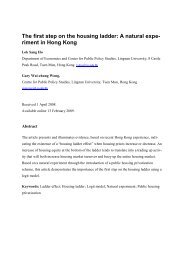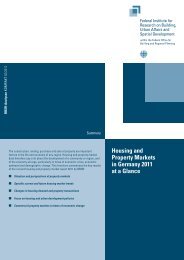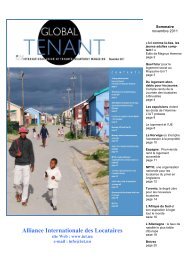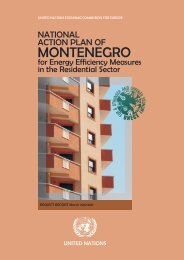housing developments in european countries - Department of ...
housing developments in european countries - Department of ...
housing developments in european countries - Department of ...
Create successful ePaper yourself
Turn your PDF publications into a flip-book with our unique Google optimized e-Paper software.
Section 2<br />
Context<br />
Context Section 2<br />
2.14 Ireland<br />
Table<br />
2.14.1<br />
Characteristics <strong>of</strong> the Hous<strong>in</strong>g Stock<br />
<strong>in</strong> Ireland, 2002<br />
Table<br />
2.14.2<br />
Economic Trends <strong>in</strong> Ireland, 1995-2001<br />
2.14.1 Policy Mak<strong>in</strong>g and<br />
Implementation<br />
The key objective <strong>of</strong> <strong>hous<strong>in</strong>g</strong> policy <strong>in</strong> Ireland is: ‘To<br />
enable every household to have available an affordable<br />
dwell<strong>in</strong>g <strong>of</strong> good quality suited to its needs, <strong>in</strong> a good<br />
environment and, as far as possible, at the tenure <strong>of</strong><br />
their choice’. The general pr<strong>in</strong>ciple underp<strong>in</strong>n<strong>in</strong>g the<br />
policy approach to achiev<strong>in</strong>g this objective is that those<br />
who can afford to do so should provide for their own<br />
<strong>hous<strong>in</strong>g</strong> needs, either through home ownership or<br />
private rented accommodation and that those who<br />
cannot provide <strong>hous<strong>in</strong>g</strong> for themselves should have<br />
access to social <strong>hous<strong>in</strong>g</strong>.<br />
This objective and pr<strong>in</strong>ciple are actualised by<br />
government with the aid <strong>of</strong> a number <strong>of</strong> strategies. The<br />
primary strategy is to oversee and seek to ma<strong>in</strong>ta<strong>in</strong> an<br />
efficient <strong>hous<strong>in</strong>g</strong> market by implement<strong>in</strong>g a multistranded<br />
approach to address <strong>hous<strong>in</strong>g</strong> needs as these<br />
emerge. In addition, a range <strong>of</strong> detailed strategies have<br />
been devised which relate to various <strong>in</strong>terventions and<br />
supports <strong>in</strong> the private and social <strong>hous<strong>in</strong>g</strong> doma<strong>in</strong>s to<br />
facilitate appropriate standards <strong>of</strong> <strong>hous<strong>in</strong>g</strong> provision<br />
and to promote social <strong>in</strong>clusion. These <strong>in</strong>clude the<br />
follow<strong>in</strong>g:<br />
■ facilitate access to home ownership by those who<br />
desire and can afford it through fiscal and other<br />
measures;<br />
■ expand the availability <strong>of</strong> <strong>hous<strong>in</strong>g</strong> (<strong>in</strong> locations that<br />
reflect the provisions <strong>of</strong> the National Spatial<br />
Strategy) to meet demand, through the development<br />
and implementation <strong>of</strong> measures <strong>in</strong> the follow<strong>in</strong>g<br />
areas: the legislative, regulatory and fiscal<br />
framework; secur<strong>in</strong>g the provision and efficient use<br />
<strong>of</strong> residential land; expansion <strong>of</strong> social <strong>hous<strong>in</strong>g</strong> and<br />
<strong>of</strong> <strong>hous<strong>in</strong>g</strong> for sale at below market value to lower<br />
<strong>in</strong>come households; enhanc<strong>in</strong>g the role <strong>of</strong> the<br />
private rented sector by reform<strong>in</strong>g legislation and<br />
promot<strong>in</strong>g <strong>in</strong>creased accommodation supply;<br />
address<strong>in</strong>g the special <strong>hous<strong>in</strong>g</strong> needs <strong>of</strong> older,<br />
disabled and homeless persons and Ireland’s<br />
Category %<br />
Permanently occupied<br />
dwell<strong>in</strong>gs by facilities No central heat<strong>in</strong>g 13.23<br />
No piped water 0.35<br />
Permanently occupied<br />
dwell<strong>in</strong>gs by number<br />
<strong>of</strong> rooms 1 room 1.41<br />
2 rooms 3.71<br />
3 rooms 7.39<br />
4 rooms 11.14<br />
5 rooms 22.59<br />
6 rooms 20.52<br />
7 or more rooms 27.56<br />
Permanently occupied<br />
dwell<strong>in</strong>gs by tenure Owner-occupied 77.4<br />
Local authority rented 6.9<br />
Privately rented 11<br />
Other 4.7<br />
Permanently occupied<br />
dwell<strong>in</strong>gs by period<br />
<strong>of</strong> construction < 1919 13.5<br />
1919-1940 8.93<br />
1941-1960 11.3<br />
1961-1970 8.9<br />
1971-1980 16.9<br />
1981-1990 13.32<br />
> 1991 22.7<br />
Permanently occupied<br />
dwell<strong>in</strong>gs by type Apartments 6<br />
Detached houses 46<br />
Semi-detached houses 27<br />
Terraced houses 20<br />
<strong>in</strong>digenous nomadic community – the Travellers –<br />
and support<strong>in</strong>g anti-poverty <strong>in</strong>itiatives under the<br />
National Anti-Poverty Strategy and the Revitalis<strong>in</strong>g<br />
Areas by Plann<strong>in</strong>g and Investment Programme;<br />
■ support <strong>hous<strong>in</strong>g</strong> advice services, through the local<br />
authority system, to enable those com<strong>in</strong>g <strong>in</strong> contact<br />
with the local authorities to obta<strong>in</strong> advice on all <strong>of</strong><br />
the available <strong>hous<strong>in</strong>g</strong> options, and<br />
■ seek to ensure appropriate <strong>hous<strong>in</strong>g</strong> standards by:<br />
promot<strong>in</strong>g susta<strong>in</strong>able, affordable, energy-efficient,<br />
architecturally appropriate new <strong>hous<strong>in</strong>g</strong><br />
construction, which employs the best available<br />
construction techniques and is adaptable to<br />
chang<strong>in</strong>g needs over its lifetime; and promot<strong>in</strong>g the<br />
Category 1995 1996 1997 1998 1999 2000 2001<br />
% % % % % % %<br />
Growth <strong>in</strong> GDP (at constant 1995 prices) (%) 9.9 8.1 11.1 8.6 11.3 10.1 6.2<br />
Unemployed persons as a % <strong>of</strong> the labour force 12.3 11.7 7.5 9.9 5.6 4.3 3.9<br />
Change <strong>in</strong> the consumer price <strong>in</strong>dex (%) Nav 2.2 1.2 2.1 2.5 5.3 4.0<br />
conservation and improvement <strong>of</strong> the public and<br />
private <strong>hous<strong>in</strong>g</strong> stock, with particular emphasis on<br />
meet<strong>in</strong>g the needs <strong>of</strong> low-<strong>in</strong>come households and<br />
regenerat<strong>in</strong>g run-down local authority estates.<br />
The Irish <strong>hous<strong>in</strong>g</strong> stock is <strong>of</strong> very recent construction<br />
<strong>in</strong> comparison with most <strong>of</strong> the other <strong>countries</strong><br />
exam<strong>in</strong>ed <strong>in</strong> this review. Over 50% <strong>of</strong> dwell<strong>in</strong>gs were<br />
built s<strong>in</strong>ce 1971 and 43% were built s<strong>in</strong>ce 1980. As a<br />
result the standard <strong>of</strong> dwell<strong>in</strong>gs is comparatively high.<br />
At central government level, the <strong>Department</strong> <strong>of</strong> the<br />
Environment, Heritage and Local Government is<br />
responsible for the formulation <strong>of</strong> <strong>hous<strong>in</strong>g</strong> policy and<br />
for oversee<strong>in</strong>g its implementation. The provision and<br />
management <strong>of</strong> social <strong>hous<strong>in</strong>g</strong> is primarily the<br />
responsibility <strong>of</strong> 88 local authorities (who act as<br />
<strong>hous<strong>in</strong>g</strong> authorities), although <strong>in</strong> recent years the<br />
voluntary and co-operative (not-for-pr<strong>of</strong>it) <strong>hous<strong>in</strong>g</strong><br />
sector has become an <strong>in</strong>creas<strong>in</strong>gly important provider<br />
<strong>of</strong> social <strong>hous<strong>in</strong>g</strong> <strong>in</strong> Ireland.<br />
In 2002, only 0.35% <strong>of</strong> dwell<strong>in</strong>gs had no piped water,<br />
while 13.23% had no central heat<strong>in</strong>g. Connection to<br />
ma<strong>in</strong>s electricity is virtually universal across both<br />
urban and rural areas, but connection to the natural<br />
gas network is ma<strong>in</strong>ly conf<strong>in</strong>ed to Dubl<strong>in</strong> and some<br />
other urban areas <strong>in</strong> the southern half <strong>of</strong> the country.<br />
The average number <strong>of</strong> persons per room <strong>in</strong> Ireland<br />
was 0.55 <strong>in</strong> 2002, which constitutes a marked fall<br />
from the equivalent figures for 1981 and 1991: 0.74<br />
and 0.64 respectively.<br />
2.14.2 Stock<br />
2.14.3 Economy<br />
In 2003, the Irish <strong>hous<strong>in</strong>g</strong> stock totalled 1,554,000<br />
As revealed <strong>in</strong> TABLE 2.14.2, Ireland has seen dramatic<br />
dwell<strong>in</strong>gs, or 391 per 1,000 <strong>in</strong>habitants, which is<br />
growth <strong>in</strong> GDP between 1995 and 2001. However, <strong>in</strong><br />
below the average for the <strong>countries</strong> under exam<strong>in</strong>ation.<br />
recent years the rate <strong>of</strong> growth <strong>in</strong> GDP has been more<br />
TABLE 2.14.1 reveals that a large majority <strong>of</strong> occupied<br />
modest; it reached 1.4% <strong>in</strong> 2003. Ireland’s General<br />
dwell<strong>in</strong>gs <strong>in</strong> Ireland (77.4%) were owner-occupied,<br />
Government Debt to GDP ratio was 32.3% at the end<br />
while 11% were rented from a private landlord. Unlike<br />
<strong>of</strong> 2002 and 32% at the end <strong>of</strong> 2003. A similar<br />
many other <strong>countries</strong> exam<strong>in</strong>ed <strong>in</strong> this review the<br />
General Government Debt to GNP ratio <strong>of</strong> 32.2% is<br />
proportion <strong>of</strong> dwell<strong>in</strong>gs that are owner-occupied <strong>in</strong><br />
forecast for 2004.<br />
Ireland has fallen <strong>in</strong> recent years while the percentage<br />
<strong>of</strong> privately rented dwell<strong>in</strong>gs has grown. In 1991,<br />
Table 2.14.2 also demonstrates that the unemployment<br />
80.2% <strong>of</strong> dwell<strong>in</strong>gs <strong>in</strong> the country were owneroccupied,<br />
while 7% were privately rented. Local<br />
rate <strong>in</strong> Ireland has fallen dramatically s<strong>in</strong>ce 1995 and<br />
that this low rate <strong>of</strong> unemployment has been<br />
authorities are the pr<strong>in</strong>cipal providers <strong>of</strong> social <strong>hous<strong>in</strong>g</strong><br />
ma<strong>in</strong>ta<strong>in</strong>ed <strong>in</strong> recent years. In the 12 months to mid<strong>in</strong><br />
Ireland. However, the percentage <strong>of</strong> dwell<strong>in</strong>gs<br />
2003 the seasonally adjusted rate <strong>of</strong> unemployment<br />
provided by this source has fallen <strong>in</strong> recent years –<br />
was 4.9%, employment <strong>in</strong>creased by 1.4%, while the<br />
from 9.7% <strong>in</strong> 1991 to 6.9% <strong>in</strong> 2002. Nevertheless, the<br />
labour force expanded by 2%. Build<strong>in</strong>g and<br />
‘other’ category <strong>in</strong> this table also <strong>in</strong>cludes non-pr<strong>of</strong>it<br />
construction employment <strong>in</strong>creased by 0.5% dur<strong>in</strong>g<br />
agencies, which, as was mentioned above, have become<br />
the year to December 2003.<br />
<strong>in</strong>creas<strong>in</strong>gly important providers <strong>of</strong> social <strong>hous<strong>in</strong>g</strong> <strong>in</strong><br />
recent years.<br />
48 European Union Report<br />
Regular National Report on Hous<strong>in</strong>g Developments <strong>in</strong> European Countries<br />
49

















